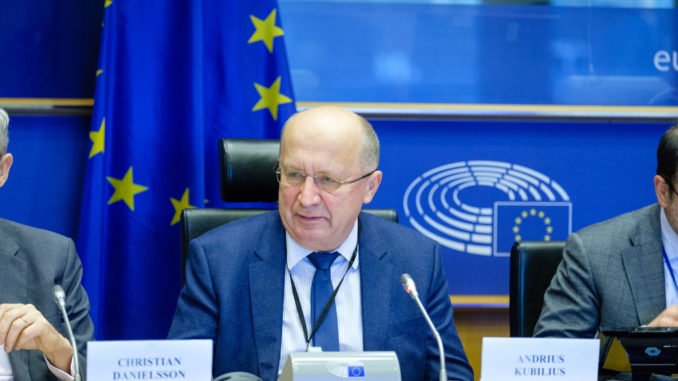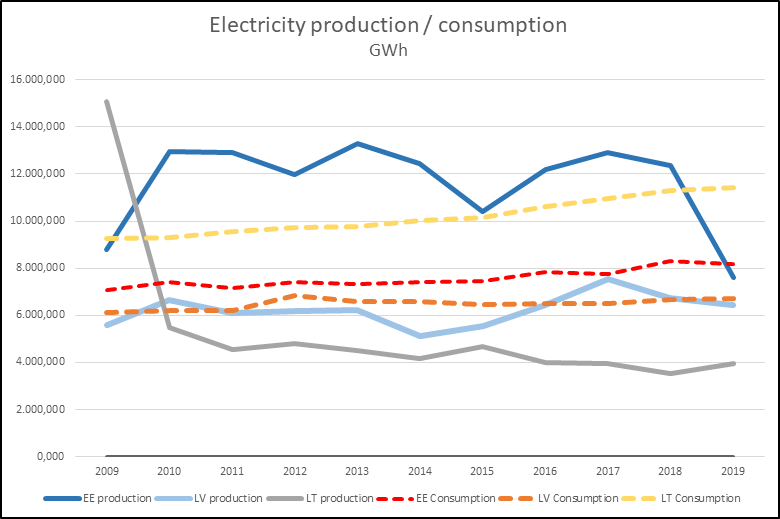
It has been announced that on November 7, Lukashenko will officially open Astravyets Nuclear power Plant. Of course, such news is cause for grave concern because Belarus’ own energy experts report that the Belarussian electrical power grid will not have necessary reserve capacities prepared all the way up to 2022, Member of the European Parliament Andrius Kubilius wrote.
This means that the launch of the nuclear plant in Astravyets could pose a threat to the entire BRELL system, which the three Baltic States are still part of. It is also evident that the recommendations on how the plant’s technological security could be improved in order to adhere to at least minimal standards, which were formulated by EU experts following stress testing at Astravyets, will not be implemented either.
Unfortunately, our chances of influencing the Lukashenko regime on these matters are null. Perhaps the situation will change when democracy prevails in Belarus.

As of today, we have a single instrument of combatting this long-term nuclear and geopolitical security threat – to not purchase and not permit export through Lithuania to other European Union countries of electrical power generated at Astravyets. It is good that political consensus was achieved on this matter in Lithuania and that it was affirmed in a special piece of legislation. It’s worth remembering that this agreement was achieved back in 2015-2016 and the Homeland Union played an important role in an agreement being reached between the parties.

Unfortunately, Lithuania’s efforts to defend itself from the unsafe Astravyets NPP are undermined by the miscommunication with our neighbours in Latvia that has surfaced in recent years. While the Latvians do make political declarations that they will not purchase electricity generated in Astravyets NPP, they are already prepared to purchase large quantities of electricity generated in Russia and to sell it on the Riga electrical exchange. According to the methodology drafted by the Latvian side, the electricity generated in Astravyets NPP or Belarus should be barred from entry to the Riga exchange (and thus, also Lithuania’s market) through the implementation of certificates (or guarantees) of electrical power origin, which will be issued by some Russian services. While S. Skvernelis’ cabinet seemingly agrees with the Latvian proposal for the new electrical import and trade with third countries methodology, many Lithuanian experts justifiably and with solid arguments say that despite this new methodology, it will be impossible to distinguish electricity generated in Astravyets NPP and, at the same time, it will not be possible to halt the sale of such electricity in Lithuania.
In most texts, Lithuanian experts present a variety of convincing technical arguments as to why this new trade methodology would not protect Lithuania from electricity generated in Astravyets NPP and how it would be harmful to Lithuania. However, most of these arguments are rather technical and for someone unacquainted with the operation of electrical power grids, it could be difficult to understand.
Due to this, in the discussion with the Latvians, I wish to talk about a slightly different aspect, which I have been concerned with for some time now. One that I have not seen suitably reflected in discussions between Lithuania and Latvia in regard to the electrical power import methodology.
It is my belief that the core question is truly simple – why do the Latvians need to import electrical power from Russia?
Usually, traders and state government import any type of commodities or goods, including electrical power, in order to meet demand in their own country or in order to re-sell to consumers in other countries. When electrical power is imported because enough is not generated within the country itself – that’s a vital matter. When electrical power is imported from a neighbour in order to sell to another neighbour – it’s just business. Sometimes not exactly a “clean business.”
In this respect, it is worth inspecting the recently emerged Latvian desire to reform the entire procedure set for the electrical power import market in the Baltic States. What causes it – do the Latvians need to import electricity from Russia because it should meet a critical demand for it on the Latvian market or are they preparing to import electricity only so that it could later be sold to Lithuania? In other words, importing solely for the sake of pure business and potentially a somewhat “unclean business.”
As such, in order to receive an answer to the simple question of why the Latvians need to import electrical power from Russia, it is worth looking into not just the technological and sometimes arcane principles of the functioning of electrical power grids and the methodologies related to them, but also to the far more simple to understand figures of electrical power generation, consumption import and export.
That said, in order to look into this, we will have to delve not only into the Latvian generation, consumption and import/export balances, but also look at all three Baltic States’ (Lithuania, Latvia and Estonia) balances because all three countries operate in the unified Baltic market.
In order to comprehend who is faced with what electrical power supply challenges, we need only have a look at three eloquent infographics, which Lithuanian energy sector experts presented during a seminar in 2019.

Figure 1 – Baltic States’ electricity market balance, 2019. Source: Eurostat
Figure 1 presents the combined Baltic States electrical power market balance for 2019. In it, we can see that the market is in a sizeable deficit, consuming far more electrical power than it generates. To cover this deficit, the Baltic States import electrical power from Sweden, Finland and a significant part from so-called “third countries” – Russia and Belarus. Some electricity is also exported to the Polish market, which is also in a deficit.
However, from this infographic, we can also make a simple and clear conclusion: the Latvian and Estonian electrical power markets are only barely in a deficit and essentially cover the insufficient generation capacities by importing electrical power from Finland through Estonia.
Basically, most of the electrical power deficit in the Baltic States’ market is created by a vast deficit in the Lithuanian market – during 2019, we consumed an entire 12.9 TWh of electrical power, while producing a meagre 3.6 TWh.
What happened to Lithuania’s electrical power generation capacities after the year 2009 when Ignalina NPP was finally closed is a whole other topic that is worthy of attention and which I will discuss a little later, but for now, a single takeaway suffices – in the joint Baltic States’ market, the electrical power deficit is essentially formed by Lithuania.
It is not Latvia or Estonia but Lithuania that is leading to a deficit. And so, it should be Lithuania who should consider how to cover the Lithuanian market’s deficit. Not the Latvians or Estonians, but the Lithuanians. It is worth noting that Lithuanians have been taking this into consideration up to now. However, the impression arises that from now on, the Latvians have decided to also deal in fulfilling the deficit in Lithuania. As such, they decided to review the entire electrical power import from third countries methodology, thus creating the risk that this way, the Lithuanian market’s deficit will be covered by electricity generated in Astravyets NPP, which will be impossible to distinguish from supposedly “legal” Russian electrical power, with both of these flowing to the Riga market through the very same BRELL ring power lines, which pass through Astravyets Nuclear Power Plant, the Ignalina switchyard and will later reach Latvia through one of the branches of the BRELL ring that travels from Ignalina.
Thus, the import of Russian electricity is not vitally important to the Latvians. They can survive just fine without it because they have sufficient local generation and cover their deficit by importing from Finland.
This means that the Latvians only require the import of Russian electricity so that this electrical power could be sold to Lithuania through Latvia. Perhaps the imported Russian electricity would also be mixed with that generated in Astravyets NPP because it will be impossible to distinguish.
How should this “business” Latvia is planning be received in Lithuania?
At the very least, it should be viewed as suspect.
It would probably be understandable if the Latvians demanded the Lithuanians explain how they intend to fill out their deficit market after Astravyets NPP launches and a prohibition comes into power in Lithuania on importing and using any Belarussian electricity because up to now, Lithuania did purchase this electrical power. The request for such an explanation from Lithuania would be understandable because all three Baltic States are interlinked and one country’s problems in securing a sufficient electrical energy supply can harm the other countries. However, the Latvians have not requested such explanations from Lithuania; at least I have not heard of any. Instead, they covertly decided that the Latvians themselves will purchase such electrical power, which the Lithuanians bought up to now from the third countries, in the name of Latvia and then sell on to Lithuania. For Latvia, this is pure business, while for Lithuania – some sort of misunderstanding. How can our brothers in Latvia participate in such a strategic fraud against Lithuania?
Furthermore, prior to accusing our brothers of such a terrible sin, it is worth taking a careful look at recent Lithuanian decisions, which could have tempted the Latvians.

Figure 2 – Lithuanian import/export, 2017-2019, GWh, Source: Eurostat
In the second figure, we can see data on how Lithuania purchased and sold electrical power between 2017 and 2019. We can see one significant change – during the three years, the quantity of electrical power purchased from (or through) Latvia fell by 3,300 GWh, while imports from Russia to Lithuania rose to the same extent (3,300 GWh). Why after the year 2018, instead of Latvian electricity Lithuania began to prefer Russian electricity is something I cannot explain. It would be good if someone from the Lithuanian energy sector would do so.

Figure 3 – volumes of electrical power trade with third countries, TWh, Source: Eurostat
With figure 3, we can also note how from 2018 onward, Lithuania also significantly increased electrical power purchases on the Belarussian-Lithuanian border – there were increases in both Russian electricity (probably Russian) sales performed by Inter RAO (from 0.64 TWh in 2017 to 3.69 TWh in 2019), as well as Belarussian electricity sales by Belenergo (from 0.14 TWh in 2017 to 1.51 in 2019). Basically, only the purchase of energy generated in Kaliningrad saw no change in Lithuania (from 2.52 GWh in 2017 to 2.62 GWh in 2019). It is worth remembering that only the Russian electricity generated in Kaliningrad cannot be mixed up in the Baltic States with electricity generated in Astravyets NPP.
Looking at such Lithuanian trade statistics, it is difficult (perhaps even impossible) to comprehend why over the past 2-3 years, Lithuania has so recklessly increased its dependency on electrical power imports through (or from) Belarus. It stands completely unclear as to what occurred in 2018 when it was decided to rapidly ramp up such imports despite the knowledge that with the launch of Astravyets NPP, this import channel will have to be closed.
When you get used to such massive imports of electrical power flowing in from Belarus, it can later on become a hard habit to drop, even if the same electricity reaches Lithuania from Latvia. If there is demand (regardless of it being restricted), supply will follow.
It would be good if someone would also explain this dynamic of Lithuanian statistics. It would be good if the incumbent, even if departing, government would do so.

Figure 4 – Lithuanian, Latvian and Estonian electrical power production/consumption, GWh. Source: Eurostat
Wrapping up, there is the question I mentioned at the beginning of the text. This question emerges after looking at figure 4, where data from Eurostat shows how electrical production and consumption changed in the three Baltic States. From the chart, we see that following the closure of Ignalina NPP in 2009, Lithuania turned from a net generator of electrical power to a clear net consumer and despite such a deficit continued reducing its generation capacities: from 5,500 GWh production in 2010, we decreased to 3,280 GWh production in 2018. At the same time, we also proceeded to increase imports of Russian electricity. We closed down Ignalina NPP, rejected the VIsaginas NPP’s construction plans through a referendum and then proceeded to also close down the old installations in Vilnius and Elektrėnai, while not replacing them with anything new and of significance, instead choosing to hand over our funds to Russia, thus supporting its energy sector.
Meanwhile, the Latvians and Estonians retained their generation capacities throughout this period, with these having essentially been sufficient to meet local demand. In 2019, the Estonians reduced their generation of electrical power in their old and polluting shale-burning plants, closing down 619 MW of old capacities, but nonetheless, they remained a country that practically generates sufficient electricity for itself.
It is difficult to comprehend the state logic in our stance, but I wonder, perhaps there is something I do not understand? Perhaps someone could explain to me and dispel my misunderstanding?
Because, as I conclude, I must once more answer the question posed in the title.
Why do the Latvians need to import electricity from Russia on the basis of a methodology drafted by the Latvians?
My answer – in order to, later on, sell such Russian/Belarussian/Astravyets electricity for a profit to Lithuania’s deficit market.
How should such Latvian plans be interpreted?
Look for your own description…
To be fair to the Latvians, I can only say that Lithuanians, in their own electrical power market, acted thus far as if they were awaiting such a step from Latvia. Or the sort of political shift in Lithuania, which would permit for electricity to flow directly from Astravyets to Lithuania.
It failed…

Be the first to comment